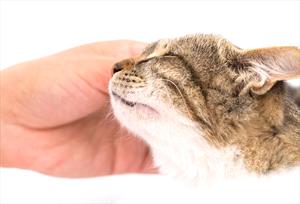Cat's face in person's hand

Photo courtesy of Depositphotos
Aspergillosis is an infection in cats caused by Aspergillus organisms, which are a type of fungus found throughout the world. Infections in cats are rare and most commonly seen in cats that have a poor immune system, such as those with certain infections (e.g. feline leukemia virus) or diseases (e.g. cancer, diabetes).
Aspergillus lives best in soil and decaying undergrowth.
Two types of aspergillosis can occur in cats: nasal aspergillosis (also called sino-orbital or sinonasal aspergillosis or upper respiratory tract aspergillosis) and disseminated (widely dispersed) aspergillosis, also sometimes called systemic aspergillosis.
Nasal aspergillosis is the most common form. Cats become infected after they inhale or breath in microscopic Aspergillus spores, which are its reproductive cells, kind of like plant seeds. The fungus then starts to grow inside the structures of the nose and face, such as the nasal cavity and sinuses.
Disseminated aspergillosis also commonly occurs from breathing in spores, but instead of just growing in the nose, the fungus travels further into the body. With disseminated aspergillosis, many organs can be infected, especially the lungs, nervous system, and gastrointestinal tract.
We don’t understand why some cats develop nasal aspergillosis while others have disseminated infections. Most cats who develop disseminated aspergillosis have a poorer immune system than those with the nasal form, which prevents the body from fighting Aspergillus and allows it to spread unchecked.
Common symptoms of nasal aspergillosis include sneezing, snoring, and nasal discharge. Sometimes the nose, eyes, or cheeks will seem swollen. Occasionally the lymph nodes under the chin enlarge. Some cats will develop a fever and/or poor appetite.
For cats with disseminated aspergillosis, coughing, trouble breathing, loose stool, disorientation, or trouble walking may occur.
Diagnosing aspergillosis is difficult. Biopsies may require specific equipment to reach infected tissue in the nose. The fungus can be hard to grow in culture and find in biopsied tissues. Aspergillus blood tests can be inaccurate depending on how far along the infection is. These problems mean that veterinarians will have to perform multiple tests to get an accurate diagnosis. In addition to blood tests, culture, and biopsy, x-rays and lab work will be needed to determine how severely the disease is affecting the body. Certain forms of imaging, such as an MRI or CT scan, may also be needed if it isn’t clear how much of the body has been infected.
Treating aspergillosis is also difficult. Areas of diseased tissue must often be surgically removed. Certain antifungal medications can be used in addition to surgery, but they are not always successful. Antifungal medications can also be expensive, and treatment may be needed for months. Even with surgery and antifungal medication, the prognosis for disseminated aspergillosis is poor. Most cats do not survive long, and their quality of life during treatment can be poor.
Cats with nasal aspergillosis have a little bit better success with treatment, but the potential for treatment failure is still high. For those that respond to treatment, reinfection or recurrence of the previous infection is common. If you suspect your cat has developed aspergillosis, get to the veterinarian as soon as you can. The sooner a diagnosis can be made, the sooner your cat can be made comfortable and start treatment.